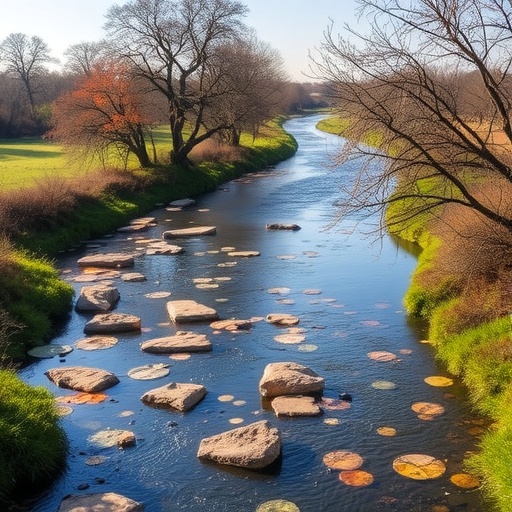In a groundbreaking study published in “Environmental Monitoring and Assessment,” researchers delve into the intricate dynamics of emerging pollutants within the Vaal River catchment area of South Africa. The Vaal River, a vital water source for millions, has experienced prolonged pollution issues that have raised urgent environmental and public health concerns. The team’s research, helmed by lead author Z.L. Mthiyane, highlights seasonal variations in the concentration and risk assessment of these pollutants, revealing critical insights regarding their environmental fate and potential impacts on human health and ecosystems.
The Vaal River is emblematic of the challenges faced by many river systems globally, where industrial discharge, agricultural runoff, and urban waste converge. The presence of emerging pollutants—substances not traditionally monitored—poses a new level of risk that necessitates comprehensive studies to understand their behavior and effects. The researchers focused on a range of compounds, including pharmaceuticals, personal care products, and other industrial chemicals, known to disrupt aquatic systems and accumulate in the food chain.
In conducting their seasonal analysis, Mthiyane and colleagues meticulously sampled water from various sites along the Vaal River. Their rigorous sampling strategy ensured that they captured the temporal dynamics of pollutant concentrations across different seasons. Results indicated a stark variation in pollutant levels, influenced by factors such as rainfall, temperature variations, and human activities, particularly during peak agricultural seasons when runoff is most pronounced.
One significant finding of the study was the marked increase in pharmaceutical residues during the summer months, coinciding with elevated levels of agricultural runoff. This correlation underscores the interconnectedness of agricultural practices and the broader water quality issues facing the Vaal River. Furthermore, the researchers utilized advanced analytical techniques, including liquid chromatography coupled with mass spectrometry, to achieve high sensitivity and specificity in detecting these emerging pollutants, thereby providing a more accurate depiction of their presence.
Beyond merely documenting concentrations, the researchers carried out a comprehensive environmental risk assessment. This assessment factored in not only the concentration of pollutants but also their toxicity and ecological significance. By employing standardized risk assessment frameworks, they quantified the potential for harm to aquatic life and humans, revealing alarming implications for communities reliant on the river for drinking water and recreational activities.
The implications of this research extend beyond the borders of South Africa. As emerging pollutants are a global issue, the findings provide a valuable reference point for other regions grappling with similar challenges. Policymakers and environmental agencies are increasingly concerned about the presence of these contaminants, particularly given their potential to cause adverse health effects. The study serves as a call to action, highlighting the need for enhanced monitoring frameworks and improved regulatory policies worldwide.
The researchers also emphasized the role of public awareness in mitigating the risks associated with emerging pollutants. Engaging local communities in understanding the sources and impacts of pollution can foster more sustainable water use practices. Involving stakeholders in the dialogue surrounding water quality has the potential to amplify the effects of regulatory measures and enhance community resilience in the face of environmental degradation.
Another critical aspect of the study was its examination of the diverse sources of pollution contributing to the challenges faced by the Vaal River. A multifaceted look at industrial discharges, agricultural runoff, and urban wastewater provided a comprehensive understanding of how these pollutants enter the river system. This nuanced approach stresses the need for collaborative efforts between various sectors to develop effective strategies for pollution reduction and management.
Ultimately, Mthiyane and colleagues position their research as a crucial component of a larger narrative surrounding environmental health. Recognizing the connection between emerging pollutants, human health, and ecological integrity is vital for sustainable management practices. With the increasing recognition of climate change and its impacts on water resources, the urgency to address pollution in rivers has never been more pronounced.
The team asserts that robust data on emerging pollutants can guide decision-making processes in environmental policy. Their disciplined scientific inquiry equips policymakers with the necessary evidence to enact changes in regulations that govern wastewater treatment, agricultural practices, and industrial processes. By advocating for stronger environmental protections, their study promotes a sustainable future for the Vaal River and its surrounding communities.
As the world inches toward a new understanding of environmental risks, research like that conducted by Mthiyane et al. will be instrumental in shaping the responses to the pressing challenges posed by pollution. Establishing a foundation of scientific knowledge is critical to inform both the public and decision-makers about the urgency of addressing these emerging threats.
In conclusion, the seasonal analysis and environmental risk assessment of emerging pollutants in the Vaal River catchment area expound on the complex interplay of environmental factors. The implications for human health, aquatic ecosystems, and public policy are profound, urging immediate action on multiple fronts. Ongoing research and community engagement will be crucial in mitigating the impacts of these pollutants, paving the way for a healthier environment for future generations.
Subject of Research: Emerging pollutants in the Vaal River catchment area of South Africa.
Article Title: Seasonal analysis and environmental risk assessment of selected emerging pollutants in the Vaal River catchment area of South Africa.
Article References:
Mthiyane, Z.L., Martínez, J.G., Khulu, S. et al. Seasonal analysis and environmental risk assessment of selected emerging pollutants in the Vaal River catchment area of South Africa.
Environ Monit Assess 197, 1264 (2025). https://doi.org/10.1007/s10661-025-14649-4
Image Credits: AI Generated
DOI: 10.1007/s10661-025-14649-4
Keywords: Emerging pollutants, Vaal River, environmental risk assessment, seasonal analysis, water quality, public health.




